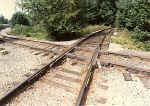by nyandw
http://www.trainsarefun.com/rvrr/rvrr.htm

http://www.trainsarefun.com/rvrr/images ... 20plan.gif

The entire line in that area was to run at "yard speed" and that limited them to a max of 15mph being able to stop short of any obstructions. A switch that had about a 10 foot high switch target on it. (Note: It was not connected to anything but the high target.) It was set one way while the LV switched the stub, and set the other way for the RV
Upon throwing the switch it would show clear to go across the diamond for the LV to service the industry east of the diamond. When completed switching the industry the signal was returned to its normal position of clear for the RVRR crews to run across the diamond crossing to switch the interchange. As with Summit, this interchange would have setouts and pickups providing a reason to have the foreign road switchers operate in the area.
Best,
Steve

http://www.trainsarefun.com/rvrr/images ... 20plan.gif

The entire line in that area was to run at "yard speed" and that limited them to a max of 15mph being able to stop short of any obstructions. A switch that had about a 10 foot high switch target on it. (Note: It was not connected to anything but the high target.) It was set one way while the LV switched the stub, and set the other way for the RV
Upon throwing the switch it would show clear to go across the diamond for the LV to service the industry east of the diamond. When completed switching the industry the signal was returned to its normal position of clear for the RVRR crews to run across the diamond crossing to switch the interchange. As with Summit, this interchange would have setouts and pickups providing a reason to have the foreign road switchers operate in the area.
Best,
Steve